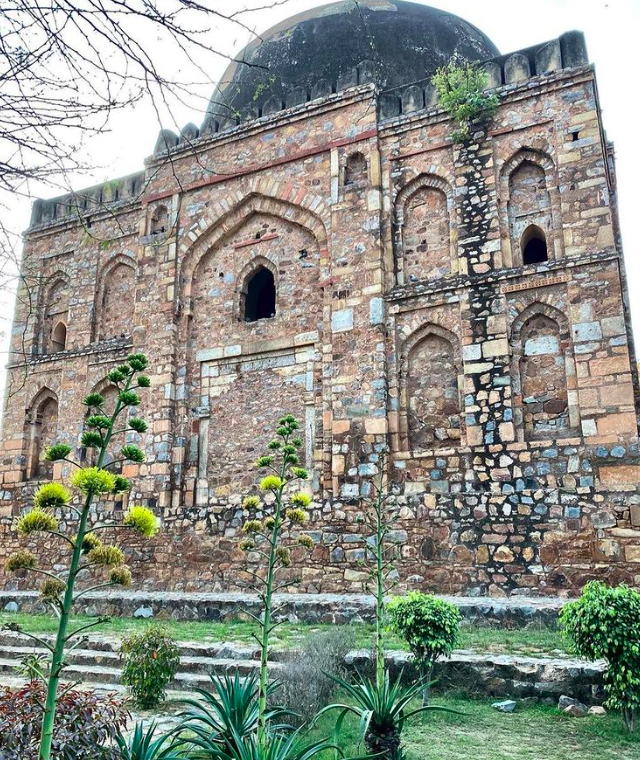Delhi is the home to some of the most beautiful UNESCO World Heritage Sites. However, it also houses some of the most unique yet lesser-known heritage gems that have been crucial in shaping the elaborate history of the city as well as the subcontinent. Here are some of the sites you must visit if you haven’t already!
1. Smith’s Folly
Since its construction in 1215, Qutub Minar has been subjected to various natural calamities, especially lightning. We find the first record of Qutub Minar being struck by lightning in 1368, destroying the top storey of the minar. The then ruler, Sultan Firoz Shah Tughlaq ordered the restoration of the minar and replaced the fallen storey with two new floors and a cupola. Records also show minor damages being fixed by Sikander Lodi in 1503.
While it was probably affected again too but we have no records for the same until 1803 when an earthquake destroyed the cupola installed by Firoz Shah. The then British Governor-General of India, Lord Wellesly authorized a British builder, Major Robert Smith to carry out the repairs of the minar, which were completed in 1828. Smith went a little above what was asked of him, and replaced the Indo-Islamic cupola with a Bengali style chhatri!. This Hindu style chhatri looked so out of the place on a tower signifying the dominance of Islamic rulers in the medieval era that Lord Hardinge, in 1848, ordered the dismantling of this chhatri and dumped it on the lawns near the Qutub Minar. Hereafter, Smith’s architectural fallacy became Smith’s Folly!
2. Tomb of Bijri Khan
The Lodi era monument lies amidst the chaos of the metro city, with slums encroaching the sides of the museum. The restoration work has gained some time in this monument’s life. Believed to be more than 600 years old, the monument was declared to be of prime archaeological significance before the Indian Trust for Art and Cultural Heritage(INTACH) started to renovate the tomb. Bijri Khan was probably a noble. Apart from this fact, no significant information is available about the tomb and the person buried at the site. The grave inside the sepulchre has no inscription. This Lodi period tomb is a rubble-built one decorated with shallow, arched niches. The only other ornamentation left is a few bands of stone carved into diamond shapes.
3. Old Viceregal Lodge
The most interesting history among all those buildings that catered to the needs of the Colonial government in Delhi shifted on a temporary basis is the Old Viceregal Lodge. The lodge is a repository of history as the galleries within contain archives of its time and the region surrounding the Northern Ridge in Delhi which served as the British cantonment during the early 20th century.
In 1803, it served as a camp for the victorious British troops. Later, it became the circuit house. In 1903, it was refurbished for Lord Curzon during the second Coronation of the second Durbar for King Edward VII. The hallmark of 1911-The Delhi Durbar, or the coronation of King George V, got the place refurbished for the third time, serving as an ancillary place in case the venue of the coronation needed to be shifted from Kingsway Camp for any reason. Initially, the lodge was part of the cantonment and then it was converted to a residence for the imperial rulers.
In 1912, the Circuit House became the temporary Viceregal Lodge. From then onwards, the building was home to the five serving Viceroys-Lord Harding, Lord Chelmsford, Lord Reading, Lord Lytton, Lord Irwin, till the construction of ‘#RashtrapatiBhavan’. The lodge also became another place of refuge during the revolt of 1857 and the basement, which is now renovated and painted anew, was once a hidden chamber that served as the dungeons and it’s said that Shaheed #BhagatSingh was once confined here.
In 1931, the famous Gandhi-Irwin pact was signed here in this building only. The convocation hall was once a majestic ballroom where Louis Mountbatten proposed to Edwina Ashley. A plaque that tells this story stands in the registrar’s office. The galleries and museum hold an exhibition of photographs dating back to the 1930s that record the story of the University of Delhi through time and also narrate stories from the time of the British era.
In 1933, it was handed over to the Delhi University. Renovated a few years ago, it is currently serving as the head of the Vice-Chancellor of the Delhi University.
4. Lal Bangla
Lal Bangla is two imperial late-Mughal mausoleums located in Delhi, India, built in (1779 – 1780) which are protected monuments under the Archaeological Survey of India. Lal Bangla is one of the most noteworthy and interesting historical monuments of the Mughal period. There is a debatable matter about the identification of the character who is buried down under the structure of Lal Bangla. A large number of historical researches suggest that the mausoleum belongs to the daughter and mother of a Mughal emperor named Shah Alam. The name of the daughter of Shah Alam is known to be Begam Jaan and of his mother as Zinat Mahal Sahiba or Lal Kunwar.
5. Tomb of Najaf Khan
The Incomplete Tomb of Najaf Khan, Mir Bakshi of the empire and Vakil-i-Mutlaq of Mughal Empire • Najaf Khan was born in 1723 in Safavid Empire and came to Delhi in 1740 after Nader Shah had displaced the Safavid dynasty in 1736. He died on 26 April 1782 after serving the Mughal Throne for 42 years.




